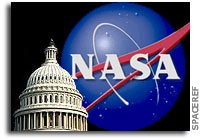Letter From Sen. Nelson to Sen. Mikulski Regarding FY 2011 NASA Budget

June 14,2010
The Honorable Barbara A. Mikulski
Chairwoman
Subcommittee on Commerce, Justice, Science and Related Agencies
Committee on Appropriations
United States Senate
Dear Barbara;
Thank you for your letter of February 16,2 010, outlining your principles for drafting the fiscal year 2011 funding bill for NASA. I share fully your sentiment that our committees must work together to define the best path forward for America’s space program. Over the last four months, I have been studying the President’s budget request, as well as various alternative proposals, in determining how we can best move ahead to the next era of human space flight. I write today to share with you some of the key elements that have emerged from that review, including discussions with Chairman Rockefeller, Ranking Member Hutchison, Senator Vitter, and other members of our Committee, which will form the bipartisan foundation of a NASA authorization bill.
The authorization bill will first identify the goals and values that provide direction to our human space flight program. I have said many times that we as a nation are driven to explore, discover, and venture across new frontiers. The bill will reflect that core element of our national identity while also coupling NASA’s human space flight efforts to national and global needs and challenges.
I believe these goals and the programmatic direction that follows will prove consistent with several of the President’s priorities, such as extending the International Space Station (ISS) and initiating a sustainable exploration program that takes advantage of new technologies and on-orbit capabilities. Likewise, the authorization bill will ensure that NASA maintains a balanced space program that includes and protects its aeronautics, science, technology, and human space flight missions. Strong cost and schedule oversight will remain essential to that effort.
At the programmatic level, the bill will propose continuing the ISS until at least 2020. The ISS serves as an important human space outpost for international and commercial collaboration and growth, research and technology development, and future exploration missions. The bill would provide the logistics and support necessary to maximize the scientific return on our investment in the ISS. Commercial cargo delivery is an important component of this overall strategy, and the flight of an additional space shuttle mission – the current “Launch on Need” flight – will help ensure that the ISS remains robust until the space shuttle is gracefully retired. This flight will only be authorized after successful completion of an independent safety review patterned after the study that you requested before the last Hubble Space Telescope servicing mission.
After retiring the last shuttle, we will soon turn to commercial space companies to deliver astronauts to the ISS. I am proposing that we take a ”walk before you run” approach for the development of commercial crew services. The bill would support the continuation and expansion of the current risk reduction, safety, and technology development effort known as the “Commercial Crew Development Program.” The bill would also require NASA to complete a number of studies, assessments, and milestones as we progress from a commercial cargo capability to commercial crew services. Astronaut safety will be the core component of all of these requirements, as with any human space flight program.
Last but not least, the authorization bill must address the future of space exploration beyond low-Earth orbit. As your letter correctly notes, our space program must have mission-driven goals. With that in mind, I am proposing that NASA embark immediately on an international effort to define near-term missions in the lunar and high- Earth orbits of space. These missions would incorporate both robotic capabilities and the development of on-orbit capabilities, technology, and infrastructure. Initial missions to Lagrange points or lunar orbit would form a foundation for follow-on missions to other destinations, ultimately leading to Mars. I am also exploring the idea of authorizing a mechanism to provide long-term strategic guidance on human space flight.
Two of NASA’s core contributions to these missions would be a heavy-lift vehicle and a crew exploration vehicle. The authorization bill will direct NASA to initiate development of a heavy-lift vehicle in fiscal year 201 1, both to support these new human space flight activities and to serve as a contingency capability to the ISS. The authorization will propose that both the heavy-lift and crew exploration vehicles leverage the workforce, contracts, assets, and capabilities of the Shuttle, Ares I, and Orion efforts.
Thank you again for your letter I look forward to our continuing discussions as we work to ensure the vitality of our nation’s space program.
Sincerely,
Senator Bill Nelson
Chairman
Subcommittee on Science and Space
Committee on Commerce, Science, and Transportation
Senator Jay Rockefeller
Senator Kay Bailey Hutchison
Senator David Vitter








